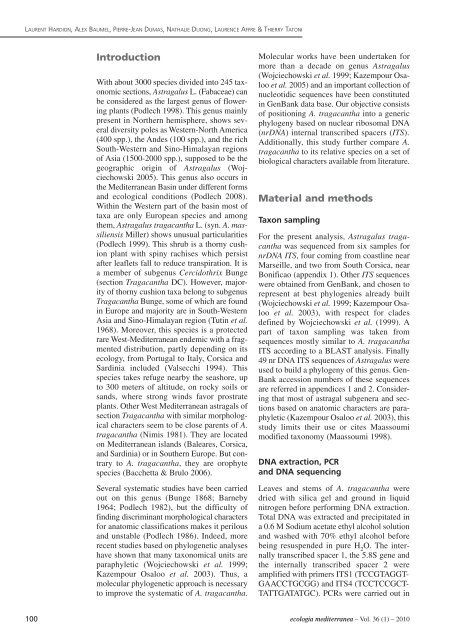Revue internationale d'écologie méditerranéenne International ...
Revue internationale d'écologie méditerranéenne International ...
Revue internationale d'écologie méditerranéenne International ...
You also want an ePaper? Increase the reach of your titles
YUMPU automatically turns print PDFs into web optimized ePapers that Google loves.
LAURENT HARDION, ALEX BAUMEL, PIERRE-JEAN DUMAS, NATHALIE DUONG, LAURENCE AFFRE & THIERRY TATONI<br />
100<br />
Introduction<br />
With about 3000 species divided into 245 taxonomic<br />
sections, Astragalus L. (Fabaceae) can<br />
be considered as the largest genus of flowering<br />
plants (Podlech 1998). This genus mainly<br />
present in Northern hemisphere, shows several<br />
diversity poles as Western-North America<br />
(400 spp.), the Andes (100 spp.), and the rich<br />
South-Western and Sino-Himalayan regions<br />
of Asia (1500-2000 spp.), supposed to be the<br />
geographic origin of Astragalus (Wojciechowski<br />
2005). This genus also occurs in<br />
the Mediterranean Basin under different forms<br />
and ecological conditions (Podlech 2008).<br />
Within the Western part of the basin most of<br />
taxa are only European species and among<br />
them, Astragalus tragacantha L. (syn. A. massiliensis<br />
Miller) shows unusual particularities<br />
(Podlech 1999). This shrub is a thorny cushion<br />
plant with spiny rachises which persist<br />
after leaflets fall to reduce transpiration. It is<br />
a member of subgenus Cercidothrix Bunge<br />
(section Tragacantha DC). However, majority<br />
of thorny cushion taxa belong to subgenus<br />
Tragacantha Bunge, some of which are found<br />
in Europe and majority are in South-Western<br />
Asia and Sino-Himalayan region (Tutin et al.<br />
1968). Moreover, this species is a protected<br />
rare West-Mediterranean endemic with a fragmented<br />
distribution, partly depending on its<br />
ecology, from Portugal to Italy, Corsica and<br />
Sardinia included (Valsecchi 1994). This<br />
species takes refuge nearby the seashore, up<br />
to 300 meters of altitude, on rocky soils or<br />
sands, where strong winds favor prostrate<br />
plants. Other West Mediterranean astragals of<br />
section Tragacantha with similar morphological<br />
characters seem to be close parents of A.<br />
tragacantha (Nimis 1981). They are located<br />
on Mediterranean islands (Baleares, Corsica,<br />
and Sardinia) or in Southern Europe. But contrary<br />
to A. tragacantha, they are orophyte<br />
species (Bacchetta & Brulo 2006).<br />
Several systematic studies have been carried<br />
out on this genus (Bunge 1868; Barneby<br />
1964; Podlech 1982), but the difficulty of<br />
finding discriminant morphological characters<br />
for anatomic classifications makes it perilous<br />
and unstable (Podlech 1986). Indeed, more<br />
recent studies based on phylogenetic analyses<br />
have shown that many taxonomical units are<br />
paraphyletic (Wojciechowski et al. 1999;<br />
Kazempour Osaloo et al. 2003). Thus, a<br />
molecular phylogenetic approach is necessary<br />
to improve the systematic of A. tragacantha.<br />
Molecular works have been undertaken for<br />
more than a decade on genus Astragalus<br />
(Wojciechowski et al. 1999; Kazempour Osaloo<br />
et al. 2005) and an important collection of<br />
nucleotidic sequences have been constituted<br />
in GenBank data base. Our objective consists<br />
of positioning A. tragacantha into a generic<br />
phylogeny based on nuclear ribosomal DNA<br />
(nrDNA) internal transcribed spacers (ITS).<br />
Additionally, this study further compare A.<br />
tragacantha to its relative species on a set of<br />
biological characters available from literature.<br />
Material and methods<br />
Taxon sampling<br />
For the present analysis, Astragalus tragacantha<br />
was sequenced from six samples for<br />
nrDNA ITS, four coming from coastline near<br />
Marseille, and two from South Corsica, near<br />
Bonificao (appendix 1). Other ITS sequences<br />
were obtained from GenBank, and chosen to<br />
represent at best phylogenies already built<br />
(Wojciechowski et al. 1999; Kazempour Osaloo<br />
et al. 2003), with respect for clades<br />
defined by Wojciechowski et al. (1999). A<br />
part of taxon sampling was taken from<br />
sequences mostly similar to A. tragacantha<br />
ITS according to a BLAST analysis. Finally<br />
49 nr DNA ITS sequences of Astragalus were<br />
used to build a phylogeny of this genus. Gen-<br />
Bank accession numbers of these sequences<br />
are referred in appendices 1 and 2. Considering<br />
that most of astragal subgenera and sections<br />
based on anatomic characters are paraphyletic<br />
(Kazempour Osaloo et al. 2003), this<br />
study limits their use or cites Maassoumi<br />
modified taxonomy (Maassoumi 1998).<br />
DNA extraction, PCR<br />
and DNA sequencing<br />
Leaves and stems of A. tragacantha were<br />
dried with silica gel and ground in liquid<br />
nitrogen before performing DNA extraction.<br />
Total DNA was extracted and precipitated in<br />
a 0.6 M Sodium acetate ethyl alcohol solution<br />
and washed with 70% ethyl alcohol before<br />
being resuspended in pure H 2 O. The internally<br />
transcribed spacer 1, the 5.8S gene and<br />
the internally transcribed spacer 2 were<br />
amplified with primers ITS1 (TCCGTAGGT-<br />
GAACCTGCGG) and ITS4 (TCCTCCGCT-<br />
TATTGATATGC). PCRs were carried out in<br />
ecologia mediterranea – Vol. 36 (1) – 2010
















